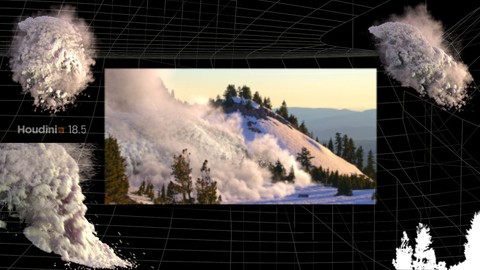
Houdini FX : Creating An Avalanche Rig
Houdini FX : Creating An Avalanche Rig, available at $64.99, has an average rating of 4.95, with 28 lectures, based on 16 reviews, and has 284 subscribers.
You will learn about We will cover all the steps needed to create a high resolution Avalanche simulation down the side of a mountain. We will review a trick to turn a still image into a moving sequence for use as our Background and discuss parallax and why it is important. We will use grains and meshing to create the mass bulk of our setup and regular particles for additional FX elements. We will use the sparse solving method to create parts of the Avalanche Simulation. We will cover setting up render layers and using Redshift to render out our passes. Mantra versions of the shaders will be supplied for students without access to Redshift. We will create a final comp using Natron, or you can use Nuke if you like. This course is ideal for individuals who are Anyone interested in seeing to create a Large scale Avalanche VFX shot inside Houdini from an FX artist with 20+ years experience in post production. or Aspiring FX artists and current working professionals looking to learn new skills or see another approach to rig creation. It is particularly useful for Anyone interested in seeing to create a Large scale Avalanche VFX shot inside Houdini from an FX artist with 20+ years experience in post production. or Aspiring FX artists and current working professionals looking to learn new skills or see another approach to rig creation.
Enroll now: Houdini FX : Creating An Avalanche Rig
Summary
Title: Houdini FX : Creating An Avalanche Rig
Price: $64.99
Average Rating: 4.95
Number of Lectures: 28
Number of Published Lectures: 28
Number of Curriculum Items: 28
Number of Published Curriculum Objects: 28
Original Price: $79.99
Quality Status: approved
Status: Live
What You Will Learn
- We will cover all the steps needed to create a high resolution Avalanche simulation down the side of a mountain.
- We will review a trick to turn a still image into a moving sequence for use as our Background and discuss parallax and why it is important.
- We will use grains and meshing to create the mass bulk of our setup and regular particles for additional FX elements.
- We will use the sparse solving method to create parts of the Avalanche Simulation.
- We will cover setting up render layers and using Redshift to render out our passes.
- Mantra versions of the shaders will be supplied for students without access to Redshift.
- We will create a final comp using Natron, or you can use Nuke if you like.
Who Should Attend
- Anyone interested in seeing to create a Large scale Avalanche VFX shot inside Houdini from an FX artist with 20+ years experience in post production.
- Aspiring FX artists and current working professionals looking to learn new skills or see another approach to rig creation.
Target Audiences
- Anyone interested in seeing to create a Large scale Avalanche VFX shot inside Houdini from an FX artist with 20+ years experience in post production.
- Aspiring FX artists and current working professionals looking to learn new skills or see another approach to rig creation.
-
Hello Houdini Artists.! This course will show you all the steps involved in setting up an Avalanche FX rig.
-
There are over 5 hours of lecture videos going over the process of creating this setup.
-
You should have working knowledge of Houdini before enrolling in this course. If you have done my previous Houdini course “Master Houdini FX”, you will have all the Houdini basics needed to be able to follow this course with ease.
-
This course is “Fast paced”, which means I will not be explaining every function of every node I use on screen. I will explain what is necessary, but basic nodes will not be explained in detail, this is to try keeping this total course time to a minimum and to not bore those that have a working knowledge of Houdini’s core functions and nodes.
-
All lectures will have Houdini hip files for you to download and any other necessary assets. There are two sets of files for students to download. Files for those rendering in Redshift, and files for those rendering in default Mantra. The rendered output of the Redshift render will not be exact to the Mantra output since they are different engines using different shaders and lighting, but they will be pretty close.
-
If you have any questions, please feel free to ask. I encourage you to watch the intro video and watch some of the “free” videos so you can get a sense of what the course is like.
-
This course will be using Houdini 18.5.499. If you have any version of Houdini that has sparse solving, then you should have no problems following along with the lecture videos. You can still do the entire course if using an earlier version(as long as it has grains), you would just have to use the dense solver for our snow powder sim.
Here is the basic breakdown of the course:
We will start by examining the still image I used to create a “2.5D” scene for us to create our Avalanche Effect in.
We will discuss what parallax is and why it is important and how to “fake it” to create what looks like moving footage from any still image.
We will show how to use grains to create a large volume of particles that stick together like a body of snow moving down a mountain side.
We will see how to do many tricks to add additional FX elements like small particles flying up from the leading edge and use sparse solving to create volumetric snow powder.
We will see how to create 3D geometry from a textured plane to generate Tree collision geometry.
I will show you a trick to get the volumetric snow powder to trigger emission of particles to act as a wind force.
We will then go into rendering and I will show how to create all the renders necessary for a full comp.
We will be using Redshift in the course and on screen, however you can use Mantra if you do not have the Redshift Plugin. There will be scene files for you to download that are setup for Redshift shaders, and another set of scene files that are for rendering with Mantra shaders.
Once all the renders are done, we will assemble a full comp using Natron, or you can use Nuke if you have access to it.
I will be presenting a very straight forward and approach to creating an FX shot like this. We will break it down into smaller sims and go through it step by step progressively building new sims from previous sims until we are done with the shot.
If you have been using Houdini for a little while, you should have no problems following this course. If you need a refresher or are just starting to use Houdini, I recommend doing my first Houdini course “Master Houdini FX” as a primer to this course.
Course Curriculum
Chapter 1: General Overview of the scene setup
Lecture 1: Introduction to the course
Lecture 2: What is Parallax…?
Lecture 3: Preparing the Background Image
Lecture 4: Shader setup Overview
Lecture 5: Note on where to find the initial file download
Lecture 6: Scene layout Overview
Chapter 2: Creating Our Simulation Rigs
Lecture 1: Setting up the Source Points
Lecture 2: Setting up the Grains – Part 1
Lecture 3: Setting up the Grains – Part 2
Lecture 4: Setting up the Grains – Part 3
Lecture 5: Creating leading edge particles
Lecture 6: Isolating the Grains Edge – part 1
Lecture 7: Isolating the Grains Edge – part 2
Lecture 8: Snow powder setup – Part 1
Lecture 9: Snow powder setup – Part 2
Lecture 10: Snow powder setup – Part 3
Lecture 11: Adding tree snow
Chapter 3: Setting up our Render nodes
Lecture 1: Meshing the Grains
Lecture 2: Setting up the Lights
Lecture 3: Render geometry nodes – Part 1
Lecture 4: Render geometry nodes – Part 2
Lecture 5: Redshift shader review
Lecture 6: Note about the BG render sequence available for download
Lecture 7: Rendering the Background
Lecture 8: Rendering the Dynamics
Lecture 9: Rendering the shadow pass
Lecture 10: Creating our comp
Chapter 4: Wrapping up the course
Lecture 1: Course wrap up
Instructors
-
Eric Ebling
Freelance Visual Effects Artist, Photographer, Painter
Rating Distribution
- 1 stars: 0 votes
- 2 stars: 0 votes
- 3 stars: 0 votes
- 4 stars: 2 votes
- 5 stars: 14 votes
Frequently Asked Questions
How long do I have access to the course materials?
You can view and review the lecture materials indefinitely, like an on-demand channel.
Can I take my courses with me wherever I go?
Definitely! If you have an internet connection, courses on Udemy are available on any device at any time. If you don’t have an internet connection, some instructors also let their students download course lectures. That’s up to the instructor though, so make sure you get on their good side!
You may also like
- Best Video Editing Courses to Learn in February 2025
- Best Music Production Courses to Learn in February 2025
- Best Animation Courses to Learn in February 2025
- Best Digital Illustration Courses to Learn in February 2025
- Best Renewable Energy Courses to Learn in February 2025
- Best Sustainable Living Courses to Learn in February 2025
- Best Ethical AI Courses to Learn in February 2025
- Best Cybersecurity Fundamentals Courses to Learn in February 2025
- Best Smart Home Technology Courses to Learn in February 2025
- Best Holistic Health Courses to Learn in February 2025
- Best Nutrition And Diet Planning Courses to Learn in February 2025
- Best Yoga Instruction Courses to Learn in February 2025
- Best Stress Management Courses to Learn in February 2025
- Best Mindfulness Meditation Courses to Learn in February 2025
- Best Life Coaching Courses to Learn in February 2025
- Best Career Development Courses to Learn in February 2025
- Best Relationship Building Courses to Learn in February 2025
- Best Parenting Skills Courses to Learn in February 2025
- Best Home Improvement Courses to Learn in February 2025
- Best Gardening Courses to Learn in February 2025






















